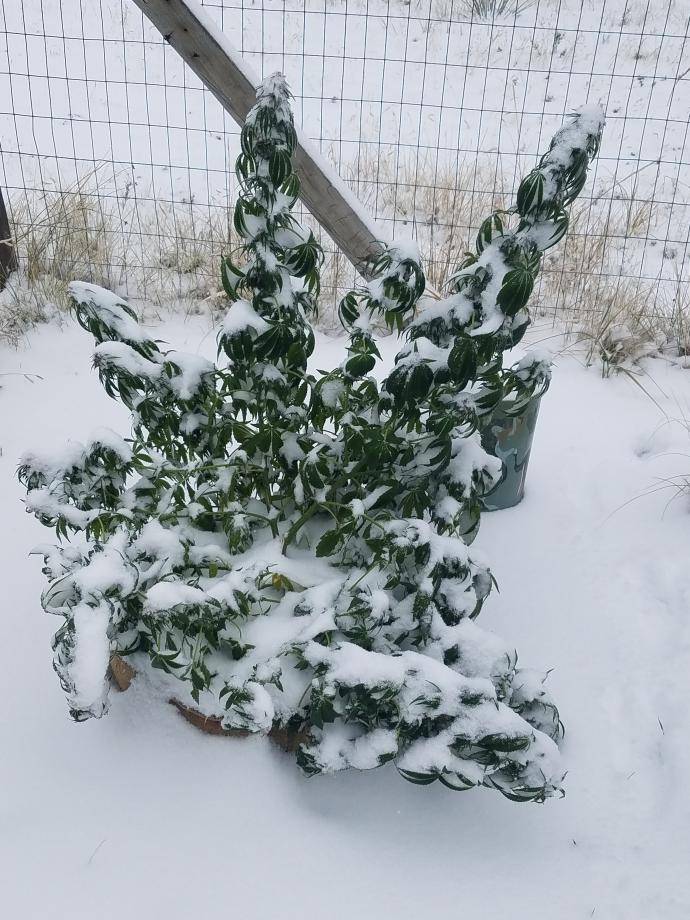I wanna grow some big plants outdoors this summer, and I originally wrote a long-winded and scattered bunch of stoned thoughts about my plans.
This is the much-edited version, written with only a mild high, and much simpler to follow!
I plan to grow several long-flowering Ace sativas: Zamaldelica, Malawi, Golden Tiger, Bangi Haze x Ethiopian.
My plan for the long-flowering strains is to force-flower them in some manner, so that they start flowering in mid July, making it much more likely that they will flower and mature before the weather turns too hatefully cold.
This is what my garden looked like on October 14 last year, so the Malawi, Zam and GT might enjoy a similar fate to the girl under that snow, if I get a long-finishing pheno!

By an odd coincidence, I'm enjoying a pleasant buzz at the moment, compliments of that very plant. Right after I took that photo, I cut the stem, shook off the snow, and took her inside to dry and cure. Besides cutting her earlier than I'd like (she could have used at least another week) that snow didn't deprive me of much.
Right after I took that photo, I cut the stem, shook off the snow, and took her inside to dry and cure. Besides cutting her earlier than I'd like (she could have used at least another week) that snow didn't deprive me of much.
But had she been a Malawi or GT, I would have been rushing to build a structure to cover her that night, because she would be nowhere near ready to harvest yet.
AT this point, I have a couple questions for the hive-mind to ponder: First, given the strains I'm hoping to grow, is there any reason to think that Zam, GT, Malawi or BHxE would not excel with longer, warmer days during flowering? They would then enjoy full twelve-hour days of sunlight in late July for their stretch, rather than the much shorter, cooler days of late August. (daytime temperatures in the summer rarely get over ninety degrees here.) Second, having grown these strains, do any of you have suggestions for training the plants during veg so that they have a good structure to carry the weight of the ginormous harvest I'm envisioning?
(could there be a more perfect smiley to accompany that notion?)
This is the much-edited version, written with only a mild high, and much simpler to follow!
I plan to grow several long-flowering Ace sativas: Zamaldelica, Malawi, Golden Tiger, Bangi Haze x Ethiopian.
My plan for the long-flowering strains is to force-flower them in some manner, so that they start flowering in mid July, making it much more likely that they will flower and mature before the weather turns too hatefully cold.
This is what my garden looked like on October 14 last year, so the Malawi, Zam and GT might enjoy a similar fate to the girl under that snow, if I get a long-finishing pheno!
By an odd coincidence, I'm enjoying a pleasant buzz at the moment, compliments of that very plant.
 Right after I took that photo, I cut the stem, shook off the snow, and took her inside to dry and cure. Besides cutting her earlier than I'd like (she could have used at least another week) that snow didn't deprive me of much.
Right after I took that photo, I cut the stem, shook off the snow, and took her inside to dry and cure. Besides cutting her earlier than I'd like (she could have used at least another week) that snow didn't deprive me of much. But had she been a Malawi or GT, I would have been rushing to build a structure to cover her that night, because she would be nowhere near ready to harvest yet.
AT this point, I have a couple questions for the hive-mind to ponder: First, given the strains I'm hoping to grow, is there any reason to think that Zam, GT, Malawi or BHxE would not excel with longer, warmer days during flowering? They would then enjoy full twelve-hour days of sunlight in late July for their stretch, rather than the much shorter, cooler days of late August. (daytime temperatures in the summer rarely get over ninety degrees here.) Second, having grown these strains, do any of you have suggestions for training the plants during veg so that they have a good structure to carry the weight of the ginormous harvest I'm envisioning?

(could there be a more perfect smiley to accompany that notion?)
Last edited:



